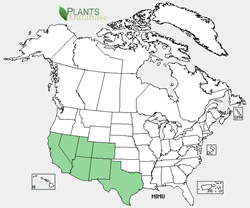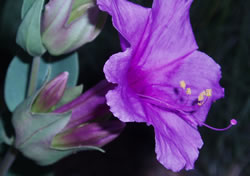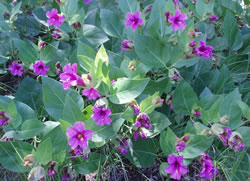Plant of the Week
 Mirabilis multiflora range map. USDA PLANTS Database.
Mirabilis multiflora range map. USDA PLANTS Database.
 Colorado four-o'clock flower and buds all projecting from a floral cup. Photo by Charlie McDonald.
Colorado four-o'clock flower and buds all projecting from a floral cup. Photo by Charlie McDonald.
 A Colorado four-o'clock plant along U.S. Highway 60 west of the Magdalena Mountains in west-central New Mexico. Photo by Charlie McDonald.
A Colorado four-o'clock plant along U.S. Highway 60 west of the Magdalena Mountains in west-central New Mexico. Photo by Charlie McDonald.
Colorado Four O'clock (Mirabilis multiflora)
By Charlie McDonald
Colorado four o'clock, also called desert, wild, showy, or Froebel’s four o'clock, is in the four o'clock family (Nyctaginaceae), which has about 30 genera and 300 species worldwide, mostly in tropical and subtropical regions. The four o'clock family has little economic importance, but the common garden four o'clock, Mirabilis jalapa, and a few species of Bougainvillea are popular ornamentals.
The Latin name, Mirabilis multiflora, translates to "marvelous multi-flowered plant", which is an apt description. This tap-rooted herbaceous perennial can grow up to 2 feet tall and 6 feet across. A mature plant can have hundreds of magenta-pink flowers 1 to 3 inches long and about 1 inch across, all blooming at the same time! As the name four o'clock implies, the flowers open late in the afternoon and wither the next day. They open sooner and stay open longer when the weather is cloudy. Each flower emerges from a floral cup formed from modified leaves and each cup has six to eight flowers that open on successive days. Plants bloom from April through September, especially after rains.
Colorado four o'clock grows in gravelly and sandy soils often in the partial shade of trees at elevations of 2,300-7,500 feet. It grows in a variety of forest, woodland, and shrub communities. It is distributed throughout the Southwest and northern Mexico. In California, it occurs only in the southern part of the State. In Texas, it occurs only in the extreme western part of the State.
Colorado four o'clock has become a popular xeriscape plant in southwestern gardens. It requires little supplemental water once established and needs plenty of space or it will smother adjacent plants. Indigenous peoples have used this plant for food and medicine.
For More Information
- PLANTS Profile - Mirabilis multiflora, Colorado four o'clock
- Hawk Moths or Sphinx Moths (Sphingidae)

